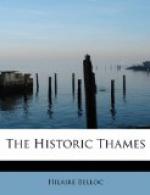In this old age of our civilisation the exactitude of the boundary which the Thames establishes is apparent in various survivals. Islands now joined to the one bank and indistinguishable from the rest of the shore are still annexed to the farther shore. Such a patch is to be found at Streatley, geographically in Berkshire, legally in Oxford; there is another opposite Staines, which Middlesex claims from Surrey. In all, half-a-dozen or more such anomalous frontiers mark the course of the old river. One arrested in process of formation may be seen at Pentonhook.
A boundary—that is, an obstacle to travel—has this further feature, that the point at which it is crossed—that is, the point at which the obstacle is surmounted—is certain to become a point of strategic and often of commercial importance. So it is with the passes over mountains and with the narrows of the sea, and so it is with fords and bridges over rivers. So it is with the Thames.
The energies both of travel and of war are driven towards and confined in such spots. Fortresses arise and towns which they may defend. Depots of goods are formed, the coining and the change of money are established, secure meeting places for speculation are founded.
Such passages over the Thames were of two sorts: there are first the original fords, numerous and primeval; next the crossing places of the great roads.
Of the original fords we have already drawn up a list. Few have, merely as fords, proved to be of strategic or commercial value. Oxford may have been an early exception; and the difficult passage at Abingdon founded a great monastery but no military post: the rise of each was connected, as was Reading (which had no ford), with the junction of a tributary. Wallingford alone, in its character of the last easy and practicable ford down the river, had for centuries an importance certainly due to geographical causes alone. Two principal events of English history—the crossing of the Thames by the Conqueror and the successful challenge of Henry II. to Stephen—depend upon the site of this crossing. Long before their time it had been of capital importance to the Saxon kings, so early as Offa and so late as Alfred. If the bridges built at Abingdon in the fifteenth century had not gradually deflected the western road, Wallingford might still count the fourteen churches and the large population which it possessed for so many centuries.
Apart from Wallingford, however, the fords, as fords, did little to build up towns or to determine the topography of English history. Of more importance were the crossings of the great roads.
When one remembers that the south of England was originally by far the wealthiest part of the country, and when one considers the shape of Ireland, it is evident that certain main tracks would lead from north to south, and that most or all of these would be compelled to cross the Thames Valley. We find four such primeval ways.




